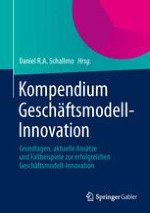2014 | OriginalPaper | Chapter
11. Kooperative Geschäftsmodellentwicklung für systemische Nachhaltigkeitsinnovationen: Eine Fallstudie im deutschen Smart Energy-Markt
Authors : Sebastian Knab, Prof. Dr. René Rohrbeck, Lars Konnertz
Published in: Kompendium Geschäftsmodell-Innovation
Publisher: Springer Fachmedien Wiesbaden
Activate our intelligent search to find suitable subject content or patents.
Select sections of text to find matching patents with Artificial Intelligence. powered by
Select sections of text to find additional relevant content using AI-assisted search. powered by
